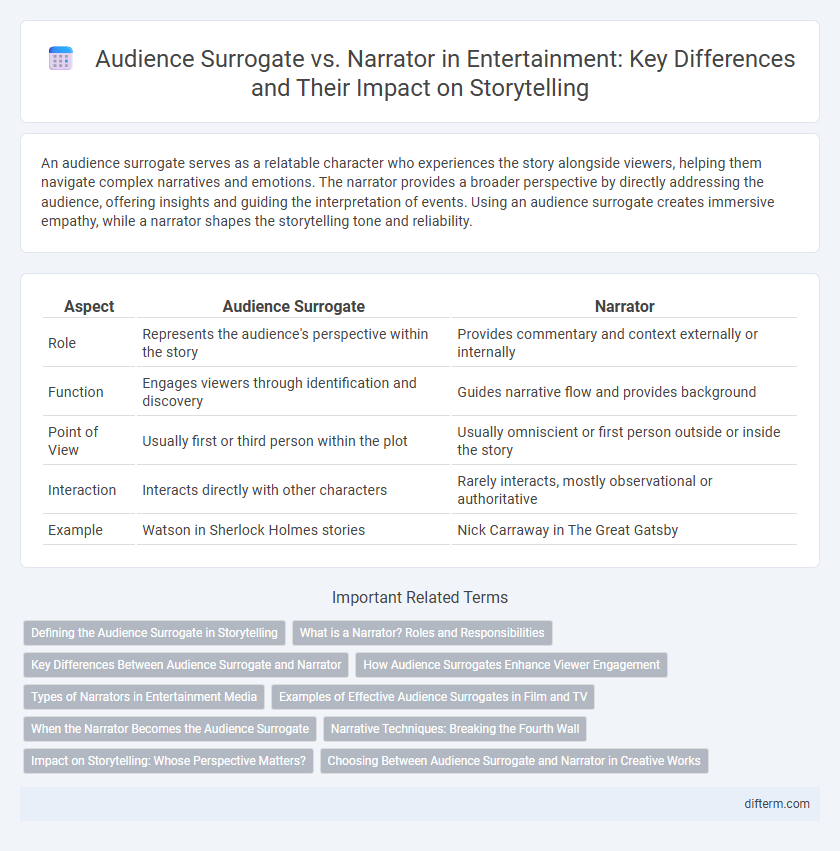An audience surrogate serves as a relatable character who experiences the story alongside viewers, helping them navigate complex narratives and emotions. The narrator provides a broader perspective by directly addressing the audience, offering insights and guiding the interpretation of events. Using an audience surrogate creates immersive empathy, while a narrator shapes the storytelling tone and reliability.
Table of Comparison
| Aspect | Audience Surrogate | Narrator |
|---|---|---|
| Role | Represents the audience's perspective within the story | Provides commentary and context externally or internally |
| Function | Engages viewers through identification and discovery | Guides narrative flow and provides background |
| Point of View | Usually first or third person within the plot | Usually omniscient or first person outside or inside the story |
| Interaction | Interacts directly with other characters | Rarely interacts, mostly observational or authoritative |
| Example | Watson in Sherlock Holmes stories | Nick Carraway in The Great Gatsby |
Defining the Audience Surrogate in Storytelling
An audience surrogate is a character within a story who represents the viewers' or readers' perspective, asking questions, experiencing discoveries, and reacting emotionally in ways that guide audience engagement. Unlike a narrator, who often provides an omniscient or retrospective viewpoint, the audience surrogate functions as a relatable entry point into the narrative world, embodying the audience's curiosity and skepticism. This character type enhances immersion by allowing the audience to vicariously experience the plot's developments and moral dilemmas.
What is a Narrator? Roles and Responsibilities
A narrator serves as the storytelling voice in entertainment, guiding the audience through the narrative by providing context, background information, and insights into characters' thoughts and motivations. Unlike an audience surrogate who experiences the story firsthand, the narrator maintains an overarching perspective that shapes the viewers' understanding and emotional engagement. Key responsibilities include establishing tone, pacing, and clarity, while ensuring the story unfolds coherently and compellingly.
Key Differences Between Audience Surrogate and Narrator
An audience surrogate is a character who represents the viewer or reader's perspective, guiding them through the story by asking questions or discovering information in real-time. In contrast, a narrator provides a structured overview or commentary, often possessing a more detached or omniscient viewpoint. The key differences lie in immediacy and immersion: the audience surrogate experiences events alongside the audience, while the narrator controls the pacing and interpretation of the narrative.
How Audience Surrogates Enhance Viewer Engagement
Audience surrogates enhance viewer engagement by providing relatable perspectives that immerse the audience in the story's emotional and narrative journey. These characters act as entry points, reflecting audience reactions and clarifying complex plot developments, which deepens understanding and investment. Unlike narrators who guide with external commentary, audience surrogates experience the plot firsthand, creating authentic connections that drive empathy and sustained interest.
Types of Narrators in Entertainment Media
Audience surrogates serve as characters through whom the audience experiences the story, often sharing their perspective and emotions, creating a relatable point of view. Narrators can be categorized into first-person, third-person omniscient, unreliable, and stream of consciousness, each providing a distinct lens on the narrative. In entertainment media, the choice between an audience surrogate and a traditional narrator significantly influences viewer engagement and the depth of storytelling.
Examples of Effective Audience Surrogates in Film and TV
Audience surrogates such as Dr. John Watson in *Sherlock* and Ron Weasley in the *Harry Potter* series effectively bridge the viewers' understanding by voicing common questions and reactions. In *The Office*, Jim Halpert serves as an audience surrogate through his knowing looks and candid commentary, enhancing viewer engagement. These characters provide relatable perspectives that guide audiences through complex narratives while maintaining immersion.
When the Narrator Becomes the Audience Surrogate
When the narrator becomes the audience surrogate, the storytelling bridges personal perspective with immersive experience, allowing viewers to perceive the narrative through the narrator's eyes. This technique enhances emotional engagement by aligning the audience's understanding directly with the narrator's insights, thoughts, and biases. Films like "Fight Club" and "The Shawshank Redemption" expertly utilize this device to deepen narrative immersion and character connection.
Narrative Techniques: Breaking the Fourth Wall
Audience surrogates serve as a relatable character through whom viewers experience the story, while narrators provide an external or reflective voice guiding interpretation. Breaking the fourth wall disrupts traditional narrative boundaries by having characters directly address the audience, blending the roles of audience surrogate and narrator. This technique enhances engagement and self-awareness, inviting viewers to question the storytelling process.
Impact on Storytelling: Whose Perspective Matters?
An audience surrogate provides a relatable viewpoint that immerses viewers or readers directly into the story world, facilitating emotional connection and comprehension through shared experiences. The narrator, however, controls the scope of information and can manipulate tone, bias, and reliability, shaping the audience's interpretation and engagement on a deeper level. Choosing between an audience surrogate and a narrator dramatically influences narrative clarity, suspense, and the overall impact of storytelling by determining whose perspective drives the plot and reveals critical thematic elements.
Choosing Between Audience Surrogate and Narrator in Creative Works
Choosing between an audience surrogate and a narrator in creative works affects storytelling perspective and audience engagement; an audience surrogate offers immersive identification by embodying the viewer's stand-in, while a narrator provides broader context and insight beyond character experience. Implementing an audience surrogate enhances emotional connection through firsthand experiences, ideal for character-driven narratives, whereas a narrator facilitates exposition and thematic layering, supporting complex or nonlinear story structures. Balancing these narrative tools depends on the desired intimacy and clarity of the story, optimizing viewer understanding and emotional impact.
audience surrogate vs narrator Infographic

 difterm.com
difterm.com